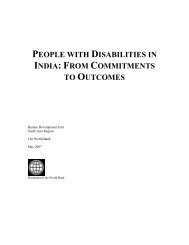FREE Download - TARSHI
FREE Download - TARSHI
FREE Download - TARSHI
Create successful ePaper yourself
Turn your PDF publications into a flip-book with our unique Google optimized e-Paper software.
Multiple methods: Some of the qualitative studies used multiple methods. This is an encouraging<br />
trend. Specific qualitative methods (e.g., FGDs) taken alone, have in-built biases that can skew<br />
research findings; the best antidote is to use a variety of methods that counterbalance one another.<br />
However, integrating the data obtained from different methods and identifying similarities and<br />
differences in findings are challenges that not many researchers have been able to deal with.<br />
Unfortunately, studies have very rarely attempted an integration of findings resulting from the use of<br />
both quantitative and qualitative methods. One exception is Ubale et al's (1997) study that has<br />
demonstrated how the two different methods can complement each other. Another is Joshi et al (1996),<br />
who in their study with rural women have attempted to compare findings from in-depth individual<br />
interviews with those from informal group discussions.<br />
Intervention programmes used participatory qualitative approaches to achieve their goals of<br />
empowerment of the communities they work with. Research based on participatory techniques also<br />
enabled the participants (e.g., adolescents) to be less inhibited and to experience a sense of agency<br />
(Ubale et al, 1996-97) during the research process.<br />
Limitations and trustworthiness: A small number of studies address the limitations of<br />
the methodology used and the caution to be exercised in interpreting the data. For example, George<br />
(1998) reflects on the possible influence of the sample selection procedure (purposive and<br />
opportunistic) on the findings. Joshi et al (1996) reflect that focus group discussions may yield a generic<br />
and exaggerated view of sexual behaviour. A frank appraisal of the shortcomings of the methodology,<br />
including the sample selection procedure, can contribute significantly towards building a body of<br />
rigorous research in the area. This is an essential element of what has been termed trustworthiness in<br />
qualitative research.<br />
Reliability and validity are used to assess the quality of quantitative studies. In qualitative research,<br />
procedures such as the quality of the interview process, transcription and translation, feedback of<br />
analysis to respondents, and identification of constraints and limitations contribute to the quality or<br />
trustworthiness of the study. A few of the qualitative studies reviewed have demonstrated a high level of<br />
trustworthiness and many have incorporated some aspects but could have gone farther.<br />
Quantitative Methods<br />
Research questions and methods: The quantitative studies reviewed here that have used large-scale<br />
surveys have used structured and semi-structured questionnaires that were either researcheradministered<br />
or self-administered. Some are in the framework of KAP studies (e.g., Sachdev's 1997<br />
study on sexual knowledge, attitudes and behaviour of Delhi university students; Reddy's 1990 study on<br />
attitudes of students, parents and teachers towards sex education), and have yielded relevant data on<br />
aspects of sexuality. Sachdev also showed a sensitivity to the issue by attempting to build rapport and<br />
create a feeling of trust in the respondents before conducting the survey.<br />
Tools and tool development: Very few studies have used rigorous standards in terms of tool<br />
development, the process of establishing reliability and validity, and pretesting /field testing of the<br />
measure(s). One of the few exceptions is Sachdev's (1997) study, wherein two local experts in the<br />
area of human sexuality vetted the questionnaire for content validity and relevance. Additionally,<br />
specific terms (e.g., 'menopause', 'orgasm', 'frigidity') were explained in the questionnaire itself.<br />
The questionnaire was pre-tested following which certain terms were further classified and a systematic<br />
procedure of tool development was followed. On the other hand, Tikoo et al (1995) studied the<br />
knowledge of 10 to 17 year old students using a questionnaire that had age-inappropriate items. (How<br />
15










